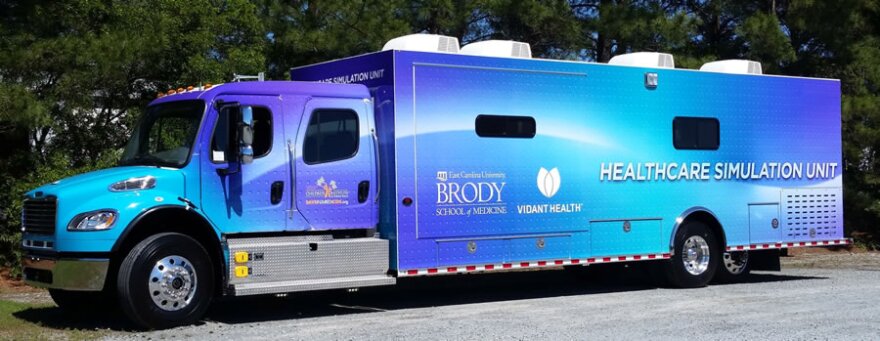The new simulation laboratory on wheels will travel around eastern North Carolina providing training to medical professionals in rural areas in an effort to improve patient outcomes.
It’s hard to miss the blue and purple fire truck sized vehicle as it starts traveling eastern North Carolina byways. Fancy paint job aside, it what’s on the inside that could potentially save lives and improve patient outcomes here in eastern North Carolina. The new mobile simulation unit based in Greenville is equipped with a hospital resuscitation bay, an ambulance compartment, high fidelity mannequins and a video monitoring system. The new vehicle is one of only nine in the country. The unit was unveiled in May, but last month the first training session took place and I was there.
“So the simulation that we’re running today is with the pediatric emergency department.”
David Schiller is the Operations Manager for the Brody School of Medicine’s Clinical Simulation Center. He says Vidant emergency room nurses and faculty physicians took part in the simulation training.
“This scenario that we’re doing today is based off of a patient that came into the hospital that was septic. A really bad infection throughout their entire body and it was a bad outcome. And they want to be able to improve on that so it’s not always a bad outcome.”
In the realistic, fully equipped hospital bay, a flat screen monitor displays vital signs for the infant mannequin that’s laying on a stretcher. To enhance the experience, makeup is applied to the face and lips make the mannequin look pale.
“They’ll go through what treatment modalities they think need to happen. And we can make this patient right here laying on the stretcher here react to the those different treatment modalities. So if they choose a treatment that’s not as beneficial to the patient as it should be, we can change the vital signs to where it makes it more critical. If they choose a treatment modality that’s really good, we can make the vital signs and the patient react to that as well.”
After the scenario was set up, three nurses gathered around the infant patient to begin treatment. Rotating cameras fixed to the ceiling inside the resuscitation bay tracked every movement and Schiller noted their progress on flat screen monitors in a separate area of the unit. Ten minutes later, a debrief allowed the nurses to work out what went right and ways to improve. Emergency Physician and Assistant Dean for Simulation Safety Education Skip Robey.
“It’s a safe environment, if you’re going to make errors, make them here. And then once you make them in a non-threatening way, sit down and discuss them and come up with a plan to avoid those the next time or be able to troubleshoot them to make the patients safe, keep our learners trainees safe, keep our practitioners safe.”
Simulation training isn’t a new concept for the Brody School of Medicine. The school got its first high fidelity mannequin in 2004. Since then, the Interprofessional Clinical Simulation Program has provided simulation based education in partnership with Vidant’s Center for Learning and Performance. The 7,500 square foot Clinical Simulation Center offers training to medical professionals and students on a wide spectrum of medical situations, from leg injury to the delivery of a newborn. Robey says many of the scenarios presented in the simulation lab are based on real-life situations.
“We reproduce them, and then we bring in our teams and we emphasize those as part of our debriefing educational objectives. So we basically have… anybody wants to come down here, we say we’re glad to have you here but instead of creating something, why don’t you bring a case scenario that just didn’t go as well as you wanted it to go. And that’s what we’ve been doing for the last 10 years.”
Before then, those receiving training would have to travel to the center in Greenville. Now, the mobile simulation unit covers 29 counties in the eastern part of the state. Vidant’s Education Specialist for Nursing Tracy Langston says this will allow them to provide high-quality training to healthcare providers in rural areas.
“One place that I know we have talked about visiting is the Outer Banks hospital. Obviously, they don’t have a simulation center there like we are able to utilize here. But now with the healthcare simulation unit, we’re still going to be able to bring them the technology, the high fidelity mannequins and everything that’s accessible to us, we’ll be able to take it to them. And they can do training for their nurses as well as their physicians.”
In addition to providing simulation training to the 20 hospitals that transfer trauma patients to Vidant, it’s possible the mobile unit could be used for military training at Camp Lejeune in Jacksonville and Fort Bragg in Fayetteville.
Last year, more than 8,000 learners passed through the center in Greenville logging over 25,000 contact hours. Now that the mobile unit is up and running, Operations manager Schiller says they could double that number this year.
“The simulation is not just about patient safety, it’s about provider safety as well. So the safer and more confident people feel in that environment, the safer they’ll feel at the bedside with an actual patient.”
The $500,000 mobile simulation unit was paid for with state funds and a grant from the Childress Institute for Pediatric Trauma to provide pediatric trauma training to hospitals in eastern North Carolina. The mobile unit is the latest innovation to bridge the gap between the classroom and real world emergency situations.



